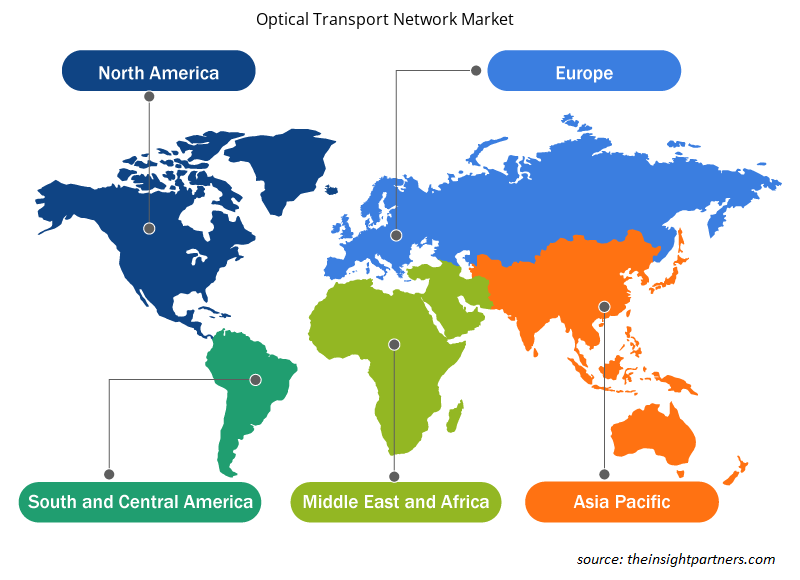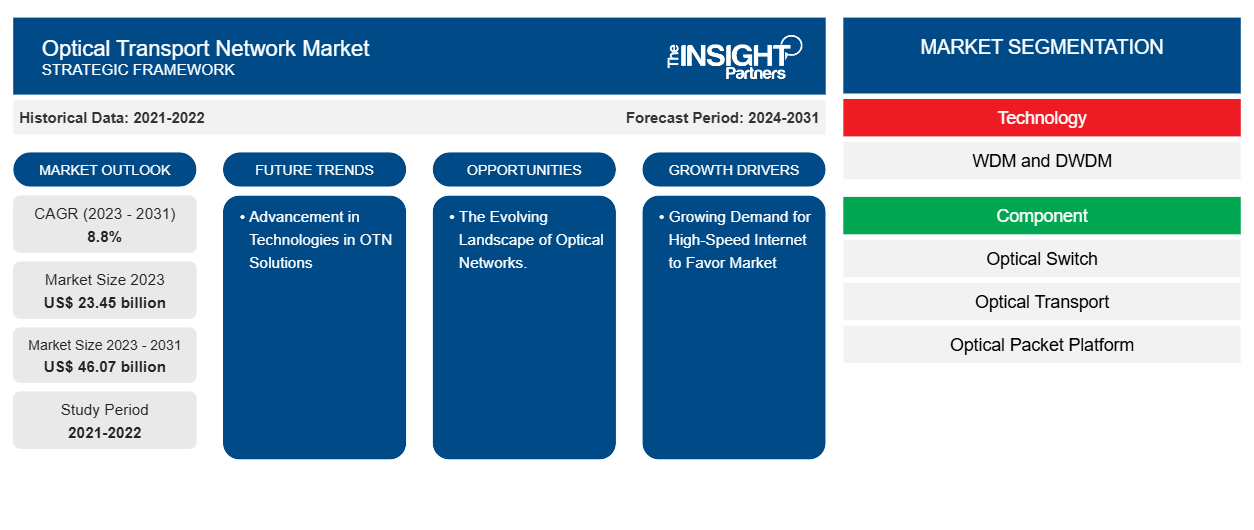من المتوقع أن يصل حجم سوق شبكة النقل البصري إلى 46.07 مليار دولار أمريكي بحلول عام 2031 من 23.45 مليار دولار أمريكي في عام 2023. ومن المتوقع أن يسجل السوق معدل نمو سنوي مركب بنسبة 8.8٪ في الفترة من 2023 إلى 2031. ومن المرجح أن يظل الطلب المتزايد على نطاق ترددي أكبر مع شبكات الإنترنت المحسنة والتقدم في التكنولوجيا التي يحرزها مزودو حلول OTN اتجاهًا رئيسيًا في سوق شبكة النقل البصري.
تحليل سوق شبكة النقل البصري
هناك حاجة متزايدة حاليًا لسعة الشبكة بسبب الارتفاع الحاد في عدد مستخدمي الإنترنت في المنازل والمكاتب. ومن المتوقع أن يكون الطلب على السوق قيد الدراسة مدفوعًا بالشعبية المتزايدة لشبكات التواصل الاجتماعي ومؤتمرات الفيديو والألعاب عبر الإنترنت وأنشطة البث المباشر الأخرى. وحقيقة أن شبكات النقل الضوئية تقلل من زمن الوصول وتوفر نقلًا سلسًا للبيانات هي أحد العوامل الرئيسية التي تدفع نمو السوق.
نظرة عامة على سوق شبكة النقل البصري
باستخدام الألياف الضوئية لنقل البيانات بين العقد، تكون شبكات النقل الضوئي (OTNs) عبارة عن شبكات متدرجة ومتسلسلة. توفر الأغطية الرقمية مثل معيار الصناعة من الجيل التالي OTN طريقة مريحة وسريعة لإرسال خدمات مختلفة عبر مسارات الضوء الضوئي. إنها عبارة عن مجموعة من عناصر الشبكة الضوئية المتصلة بالألياف الضوئية القادرة على نقل القنوات الضوئية التي تنقل إشارات العميل وإرسالها وإرسالها والتحكم فيها ومراقبتها والحفاظ على تشغيلها.
قم بتخصيص هذا التقرير ليناسب متطلباتك
ستحصل على تخصيص لأي تقرير - مجانًا - بما في ذلك أجزاء من هذا التقرير، أو تحليل على مستوى الدولة، وحزمة بيانات Excel، بالإضافة إلى الاستفادة من العروض والخصومات الرائعة للشركات الناشئة والجامعات
-
احصل على أهم اتجاهات السوق الرئيسية لهذا التقرير.ستتضمن هذه العينة المجانية تحليلاً للبيانات، بدءًا من اتجاهات السوق وحتى التقديرات والتوقعات.
محركات وفرص سوق شبكة النقل البصري
تزايد الطلب على الإنترنت عالي السرعة لصالح السوق
إن الحاجة إلى انتشار الإنترنت تتأثر أيضًا بدرجة التحضر. وبسبب هذه التطورات، يستخدم المزيد من الأفراد الإنترنت، وهو ما يعود بالنفع على نمو السوق. بالإضافة إلى ذلك، فإن مفهوم المدن الذكية يدفع الطلب على الإنترنت عالي السرعة. أحد العناصر الأساسية للبنية التحتية للمدن الذكية هو إنترنت الأشياء، الذي يربط بين العديد من الأجهزة في المجالات العامة والتجارية والشخصية - من الهواتف المحمولة إلى الأجهزة القابلة للارتداء.
المشهد المتطور للشبكات البصرية.
تتغير بيئة الشبكة الضوئية بسرعة، ومن المتوقع أن تتوسع بشكل كبير في السنوات القادمة. وقد ألقى الوباء الضوء على أهمية الشبكات الافتراضية للترفيه وكذلك الدراسة عن بعد والعمل من المنزل، على الرغم من التحديات المرتبطة بإدارة النقل الضوئي. ومن المتوقع أن تزداد جميع فئات الشبكة بشكل كبير على مدى السنوات القليلة القادمة. وتتصل حافة الشبكة بنطاق عريض سكني ولا يتخلف المترو كثيرًا عن اتصال مركز البيانات .
تقرير تحليل تجزئة سوق شبكة النقل البصري
إن القطاعات الرئيسية التي ساهمت في اشتقاق تحليل سوق شبكة النقل البصري هي التكنولوجيا والمكونات والخدمة والاستخدام النهائي.
- بناءً على التكنولوجيا، ينقسم سوق شبكة النقل البصري إلى WDM وDWDM. قطاع WDMومن المتوقع أن ينمو خلال الفترة المتوقعة.
- من حيث المكونات، يتم تقسيم السوق إلى مفاتيح بصرية، ونقل بصري، ومنصات حزم بصرية. ومن المتوقع أن ينمو قطاع المفاتيح البصرية خلال فترة التنبؤ.
- بناءً على الخدمة، ينقسم سوق شبكة النقل البصري إلى تصميم الشبكة وصيانة الشبكة ودعمها. ومن المتوقع أن ينمو قطاع تصميم الشبكة خلال فترة التنبؤ.
- من حيث المستخدمين النهائيين، ينقسم السوق إلى مقدمي خدمات الاتصالات والمؤسسات والحكومة. ومن المتوقع أن ينمو قطاع مقدمي خدمات الاتصالات بمعدل كبير خلال الفترة المتوقعة.
تحليل حصة سوق شبكات النقل البصري حسب المنطقة الجغرافية
ينقسم النطاق الجغرافي لتقرير سوق شبكة النقل البصري بشكل أساسي إلى خمس مناطق: أمريكا الشمالية، ومنطقة آسيا والمحيط الهادئ، وأوروبا، والشرق الأوسط وأفريقيا، وأمريكا الجنوبية/أمريكا الجنوبية والوسطى. سيطرت أمريكا الشمالية على سوق شبكة النقل البصري. وقد أدت اتجاهات تبني التكنولوجيا العالية في مختلف الصناعات في منطقة أمريكا الشمالية إلى تغذية نمو سوق شبكة النقل البصري. ومن المتوقع أن تؤدي عوامل مثل زيادة اعتماد الأدوات الرقمية والإنفاق التكنولوجي العالي من قبل الوكالات الحكومية إلى دفع نمو سوق شبكة النقل البصري في أمريكا الشمالية. علاوة على ذلك، فإن التركيز القوي على البحث والتطوير في الاقتصادات المتقدمة في الولايات المتحدة وكندا يجبر اللاعبين في أمريكا الشمالية على جلب حلول متقدمة تقنيًا إلى السوق. بالإضافة إلى ذلك، تمتلك الولايات المتحدة عددًا كبيرًا من اللاعبين في سوق شبكة النقل البصري الذين يركزون بشكل متزايد على تطوير حلول مبتكرة. تساهم كل هذه العوامل في نمو سوق شبكة النقل البصري في المنطقة.
نطاق تقرير سوق شبكات النقل البصري
رؤى إقليمية حول سوق شبكة النقل البصري
لقد قام المحللون في Insight Partners بشرح الاتجاهات والعوامل الإقليمية المؤثرة على سوق شبكة النقل البصري طوال فترة التوقعات بشكل شامل. يناقش هذا القسم أيضًا قطاعات سوق شبكة النقل البصري والجغرافيا في جميع أنحاء أمريكا الشمالية وأوروبا ومنطقة آسيا والمحيط الهادئ والشرق الأوسط وأفريقيا وأمريكا الجنوبية والوسطى.

- احصل على البيانات الإقليمية المحددة لسوق شبكة النقل البصري
نطاق تقرير سوق شبكة النقل البصري
| سمة التقرير | تفاصيل |
|---|---|
| حجم السوق في عام 2023 | 23.45 مليار دولار أمريكي |
| حجم السوق بحلول عام 2031 | 46.07 مليار دولار أمريكي |
| معدل النمو السنوي المركب العالمي (2023 - 2031) | 8.8% |
| البيانات التاريخية | 2021-2022 |
| فترة التنبؤ | 2024-2031 |
| القطاعات المغطاة |
حسب التكنولوجيا
|
| المناطق والدول المغطاة |
أمريكا الشمالية
|
| قادة السوق وملفات تعريف الشركات الرئيسية |
|
كثافة اللاعبين في السوق: فهم تأثيرها على ديناميكيات الأعمال
يشهد سوق شبكات النقل الضوئي نموًا سريعًا، مدفوعًا بالطلب المتزايد من المستخدم النهائي بسبب عوامل مثل تفضيلات المستهلك المتطورة والتقدم التكنولوجي والوعي المتزايد بفوائد المنتج. ومع ارتفاع الطلب، تعمل الشركات على توسيع عروضها والابتكار لتلبية احتياجات المستهلكين والاستفادة من الاتجاهات الناشئة، مما يؤدي إلى زيادة نمو السوق.
تشير كثافة اللاعبين في السوق إلى توزيع الشركات أو المؤسسات العاملة في سوق أو صناعة معينة. وهي تشير إلى عدد المنافسين (اللاعبين في السوق) الموجودين في مساحة سوق معينة نسبة إلى حجمها أو قيمتها السوقية الإجمالية.
الشركات الرئيسية العاملة في سوق شبكة النقل البصري هي:
- فوجيتسو
- شركة هواوي للتكنولوجيا المحدودة
- شركة ZTE
- شركة سيسكو سيستمز
- منظمة ALE الدولية
- شبكات أدتران
إخلاء المسؤولية : الشركات المذكورة أعلاه ليست مرتبة بأي ترتيب معين.

- احصل على نظرة عامة على أهم اللاعبين الرئيسيين في سوق شبكة النقل البصري
أخبار سوق شبكة النقل البصري والتطورات الأخيرة
يتم تقييم سوق شبكة النقل البصري من خلال جمع البيانات النوعية والكمية بعد البحث الأولي والثانوي، والتي تتضمن منشورات الشركات المهمة وبيانات الجمعيات وقواعد البيانات. فيما يلي قائمة بالتطورات في السوق:
- في مارس 2024، ستستخدم شركة Transworld Associates (TWA) حل النقل البصري من نوكيا لبناء شبكة بصرية جديدة تربط باكستان والإمارات العربية المتحدة وسلطنة عمان كجزء من خطتها لتوسيع القدرة البحرية. كما يتم نشر نظام نقل احتياطي للقدرة البحرية في مترو كراتشي. سيدعم المشروع التحول في المنطقة من خلال استيعاب النمو الهائل في روابط البيانات والنطاق الترددي بين مراكز البيانات.
(المصدر: نوكيا، بيان صحفي، 2024)
- في نوفمبر 2023، دخلت شركة نوكيا في شراكة مع شركة بهارتي إيرتيل من أجل نشر شبكة نقل بصرية لتلبية المتطلبات المتزايدة لمشهد SG في الهند. سيوفر هذا التعاون لشركة إيرتيل سعة وموثوقية معززتين، مما يؤدي إلى تحسين الخدمات المقدمة لعملائها. ستستفيد إيرتيل من مفاتيح OTN من نوكيا لترقية البنية الأساسية لتبديل النقل وزيادة السعة الإجمالية وكفاءة النطاق الترددي.
(المصدر: Aptean، بيان صحفي، 2022)
تغطية تقرير سوق شبكات النقل البصري والمنتجات النهائية
يوفر تقرير "حجم سوق شبكة النقل البصري والتوقعات (2021-2031)" تحليلاً مفصلاً للسوق يغطي المجالات التالية:
- حجم السوق والتوقعات على المستويات العالمية والإقليمية والوطنية لجميع قطاعات السوق الرئيسية التي يغطيها النطاق
- ديناميكيات السوق مثل المحركات والقيود والفرص الرئيسية
- الاتجاهات المستقبلية الرئيسية
- تحليل مفصل لقوى PEST/Porter الخمس وSWOT
- تحليل السوق العالمي والإقليمي الذي يغطي اتجاهات السوق الرئيسية واللاعبين الرئيسيين واللوائح والتطورات الأخيرة في السوق
- تحليل المشهد الصناعي والمنافسة الذي يغطي تركيز السوق، وتحليل خريطة الحرارة، واللاعبين البارزين، والتطورات الأخيرة
- ملفات تعريف الشركة التفصيلية
- التحليل التاريخي (سنتان)، سنة الأساس، التوقعات (7 سنوات) مع معدل النمو السنوي المركب
- تحليل PEST و SWOT
- حجم السوق والقيمة / الحجم - عالمي، إقليمي، بلد
- الصناعة والمنافسة
- مجموعة بيانات إكسل
التقارير الحديثة
شهادات العملاء
سبب الشراء
- اتخاذ قرارات مدروسة
- فهم ديناميكيات السوق
- تحليل المنافسة
- رؤى العملاء
- توقعات السوق
- تخفيف المخاطر
- التخطيط الاستراتيجي
- مبررات الاستثمار
- تحديد الأسواق الناشئة
- تحسين استراتيجيات التسويق
- تعزيز الكفاءة التشغيلية
- مواكبة التوجهات التنظيمية























 احصل على عينة مجانية ل - سوق شبكة النقل البصري
احصل على عينة مجانية ل - سوق شبكة النقل البصري